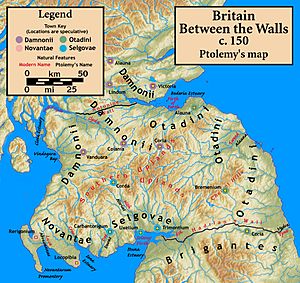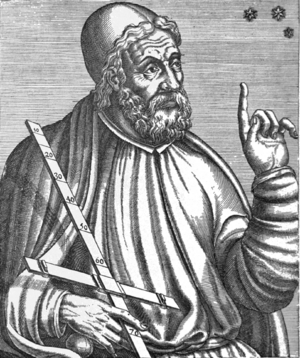Damnonii facts for kids
The Damnonii were an ancient group of people who lived in what is now southern Scotland. They were a Brittonic people, which means they spoke an early form of the Brythonic language, similar to old Welsh. We know about them mainly from a map and book called Geography, written by a Greek scholar named Ptolemy around 150 AD. He sometimes called them "Damnii" too.
The Romans, led by Agricola, campaigned in this area around 81 AD. The land was under Roman control, at least partly, between the time Hadrian's Wall was built (around 122 AD) and the Antonine Wall (around 142 AD). The Romans eventually pulled back to Hadrian's Wall in 164 AD. Ptolemy wrote his book during this time, so his information about the Damnonii is from that period.
Contents
What Does the Name Damnonii Mean?
The name "Damnonii" is very similar to other ancient British tribes. For example, the Dumnonii lived in Cornwall and Devon in England. There was also a tribe called the Fir Domnann in Ireland. Even though the names are alike, there is no proof that these groups were the same people or came from the same family. Their names probably just come from similar-sounding words.
The name "Damnonii" likely comes from an old Celtic word, *dumno-, which means "the deep" or "inner earth." So, the Damnonii might have been called "the deep ones" or "deep valley dwellers." This could be because they lived in the valleys of the River Clyde and Ayrshire. Another idea is that they were known for mining, and their name came from digging deep into the earth for ore deposits.
What We Know from History
The only ancient record of the Damnonii and their "towns" comes from Ptolemy. He listed places like Vanduara, Colania, Coria, Alauna, Lindum, and Victoria. However, these were not really towns as we know them today. They were probably Roman military camps or strongholds used by the local people.
It is very hard to figure out exactly where these places were located today. Many historians have tried to guess, but there is not enough information to be certain. Some famous historians who tried to map these locations include William Camden, John Horsley, and William Roy.
For example, Alauna has been suggested to be near Falkirk, Stirling, or even an island called Inchkeith. Colania might have been near Lanark. Lindum could have been Kirkintilloch or Linlithgow. Victoria has been linked to places like Dalginross or Abernethy. As you can see, there are many different ideas!
For a long time, historians were tricked by a fake book called The Description of Britain (or De Situ Britanniae). This book claimed to be an ancient Roman account of Britain and even had a "better" version of Ptolemy's map. Many historians believed it was real until it was proven to be a fake in 1845. Even after it was known to be false, some people still used it as a source until the late 1800s.
What Happened Later?
After the Romans finally left Scotland around 210 AD, the Damnonii seem to disappear from historical records. We do not know exactly when they formed a larger kingdom. However, by the early 400s, letters from Saint Patrick mention a "king of Altclut" (Ceretic Guletic). Altclut was a strong fort, later known as Dumbarton Rock. This king's family might have been Damnonii leaders with Roman-sounding names. This suggests that some Damnonii leaders had adopted Roman ways or had contact with the Roman Empire. From this point on, the Kingdom of Strathclyde seems to take the place of the Damnonii in history.
How They Got Along with the Romans
There is no evidence of big battles between the Damnonii and the Romans. This suggests that they might have worked together. However, during the 2nd century, there was a big increase in forest cover in Scotland. This could mean that the local population dropped, possibly due to disease.
Southern Scotland was like a border area between Roman Britain and the Caledonians to the north. Later, in the 2nd century, there were attacks on Hadrian's Wall. This might show that relations between the Romans and the local tribes changed. In 364 AD, a group called the Attacotti attacked Roman Britain, along with the Irish, Picts, and Saxons. Some historians think the Attacotti might have been the Damnonii, especially since one of their forts was called Alt Clut, which later became the capital of the Kingdom of Strathclyde.
See also



